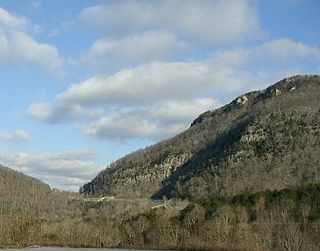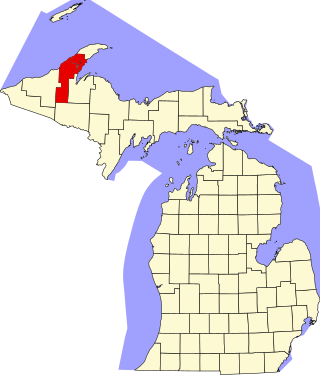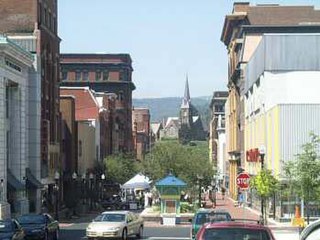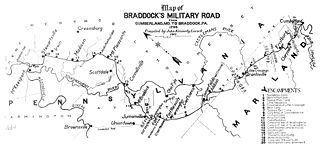
Harlan County is a county located in southeastern Kentucky. As of the 2020 census, the population was 26,831. Its county seat is Harlan. It is classified as a moist county - a one in which alcohol sales are prohibited, but containing a "wet" city - in this case Cumberland, where package alcohol sales are allowed. In the city of Harlan, restaurants seating 100+ may serve alcoholic beverages.

Benham is a home rule-class city in Harlan County, Kentucky, in the United States. The city was formally incorporated by the General Assembly in 1961. The population was 512 at the 2020 census, up from 500 at the 2010 census.

Cumberland is a city in and the county seat of Allegany County, Maryland, United States. At the 2020 census, the city had a population of 19,076. Located on the Potomac River, Cumberland is a regional business and commercial center for Western Maryland and the Potomac Highlands of West Virginia. It is the primary city of the Cumberland metropolitan area, which had 95,044 residents in 2020.

Cookeville is the county seat and largest city of Putnam County, Tennessee, United States. As of the 2020 United States census, its population was reported to be 34,842. It is recognized as one of the country's micropolitan areas, or smaller cities which function as significant regional economic hubs. Of the twenty micropolitan areas in Tennessee, Cookeville is the largest. The Cookeville micropolitan area's 2010 Census population was 106,042. The U.S. Census Bureau ranked the Cookeville micropolitan area as the 7th largest-gaining micropolitan area in the country between 2018 and 2019, with a one-year gain of 1,796 and a 2019 population of 114,272. The city is a college town, home to Tennessee Tech.

Roslyn is a city in Kittitas County, Washington, United States. The population was 893 at the 2010 census. Roslyn is located in the Cascade Mountains, about 80 miles east of Seattle. The town was founded in 1886 as a coal mining company town. During the 20th century, the town gradually transitioned away from coal, and today its economy is primarily based on forestry and tourism. The town was the filming location for The Runner Stumbles, Northern Exposure, and The Man in the High Castle. Many of the town's historical structures have been preserved, and its downtown was added to the National Register of Historic Places in 1978.

The Cumberland Gap is a pass in the eastern United States through the long ridge of the Cumberland Mountains, within the Appalachian Mountains and near the tripoint of Kentucky, Virginia, and Tennessee. At an elevation of 1,631 feet (497 m) above sea level, it is famous in American colonial history for its role as a key passageway through the lower central Appalachians.

This is a list of the National Register of Historic Places listings in Houghton County, Michigan.

11 East Forsyth, formerly known as the Lynch Building and the American Heritage Life Building, is a historic structure in Jacksonville, Florida. Originally developed by Stephen Andrew Lynch, as its current name suggests, it is located at 11 East Forsyth Street in Downtown Jacksonville. On December 23, 2003, it was added to the U.S. National Register of Historic Places.

Downtown Grand Forks is the original commercial center of Grand Forks, North Dakota, United States. Located on the western bank of the Red River of the North, the downtown neighborhood is situated near the fork of the Red River and the Red Lake River. While downtown is no longer the dominant commercial area of the Greater Grand Forks community, it remains the historic center of Grand Forks. An 80.4-acre (32.5 ha) portion was listed on the National Register of Historic Places in 2005, as Downtown Grand Forks Historic District. Today, downtown Grand Forks is home to many offices, stores, restaurants, and bars.

The Downtown Cumberland Historic District, also referred to as the Downtown Cumberland Mall, is the main shopping and dining district for the city of Cumberland, Maryland.

The Central City/Black Hawk Historic District is a National Historic Landmark District that encompasses the developed areas of Central City and Black Hawk, Colorado, United States. They are adjacent former gold mining camps in the Front Range of the Rocky Mountains in Gilpin County, Colorado. For a time, the area was known as the Richest Square Mile on Earth, and was the largest urban area of the Colorado Territory in the 1870s.

Cumberland, Maryland is named after the son of King George II, Prince William, the Duke of Cumberland. It is built on the site of the old Fort Cumberland, a launch pad for British General Edward Braddock's ill-fated attack on the stronghold of Fort Duquesne during the French and Indian War.

The Calumet Downtown Historic District is a historic district located in Calumet, Michigan, on 5th Street and 6th Street, between Scott Street and Pine Street. It is also known as the Red Jacket Downtown Historic District, reflecting the original name of the village. The Historic District is completely contained in the Calumet Historic District and the Keweenaw National Historical Park. It was designated a Michigan State Historic Site in 1973 and listed on the National Register of Historic Places in 1974. Much of the 100 block of 5th street was destroyed in a fire that took place on May 22, 2021

The Calumet Historic District is a National Historic Landmark District that encompasses most of the village of Calumet, Michigan. The district was designated in 1989 for the community's importance in the history of the region's copper mining industry.

The Downtown Evanston Historic District in Evanston, Wyoming includes about sixty buildings in a compact downtown commercial district.

The Kentucky Coal Museum is heritage center located in Benham, Kentucky. Its focus is the history of the coal industry in Eastern Kentucky, featuring specific exhibits on the company towns of Benham and neighboring Lynch. It is housed in a former company store that was built by International Harvester in 1923. In June 1990, the Tri-City Chamber of Commerce purchased the building for the future site of the museum. After receiving additional grants from the state of Kentucky, the museum opened in May 1994.
The Flatiron Building was an historic building in Grand Forks, North Dakota, that was built in 1906 and was destroyed by the 1997 Red River flood. It was listed on the National Register of Historic Places, but was removed from the Register in 2004 because it had been destroyed.

The Provo Downtown Historic District is a 25-acre (10 ha) historic area located in Provo, Utah, United States. It is listed on the National Register of Historic Places.

The Benham Historic District is a historic district encompassing ten buildings and a public park in Benham, Kentucky. The buildings form the historic center of the coal town of Benham. Benham was founded by Wisconsin Steel, a subsidiary of International Harvester, in 1912; its major buildings were built between 1919 and 1928, replacing the original buildings as the town grew. Mining operations declined during the Great Depression, and as a result the district represents the main period of development in the town. The buildings in the district include Benham's city hall, post office, grade school, Methodist church, jail, theatre, hospital, firehouse, company store, and meat market.

The Morristown Main Street Historic District is a National Register of Historic Places' historic district in Morristown, Tennessee, United States. It is primarily focused on the central business district area of Morristown.


















